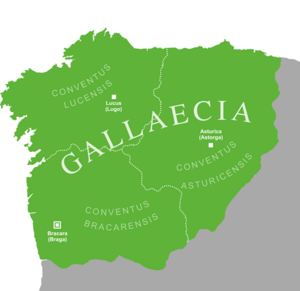Gallaecia facts for kids
Gallaecia, also known as Hispania Gallaecia, was a Roman province in the northwest part of Hispania. Today, this area includes Galicia, northern Portugal, Asturias, and Leon. It later became the Kingdom of Gallaecia. Important Roman cities there were Cale (Porto), Bracara Augusta (Braga), Lucus Augusti (Lugo), and Asturica Augusta (Astorga).
Contents
What was Gallaecia?
The Romans named this part of Hispania Gallaecia after the Celtic tribes who lived there. These tribes were called the Gallaeci or Gallaecians.
The Gallaeci tribes first appeared in written history in an old poem called Punica. This poem described them as skilled fighters who were good at predicting the future. They sang their own songs and danced to a rhythm, using small shields called caetrae.
Gallaecia was known to the Romans for its many castros. These were hillforts, which were fortified settlements built on hills. The region was also famous for its rich gold mines. This unique culture spread across modern-day Galicia, northern Portugal, western Asturias, and parts of Bierzo and Sanabria. It was different from the Lusitanian culture to the south.
An old Irish story, Lebor Gabála Érenn, even says that the Gaels sailed from Gallaecia to conquer Ireland. They had taken Gallaecia by force, and then moved on to Ireland.
History of Gallaecia
Before the Romans
Before the Romans arrived, the people of the northwestern Atlantic coast of Iberia were described by Strabo, a Greek writer. He said that the Gallaicans were a very strong and brave group. They lived in the mountains and were very hard to fight. Because of their strength, the Roman general who defeated the Lusitanians was even given the nickname Gallaicus, meaning "conqueror of the Gallaicoi."
Roman Gallaecia
After the Punic Wars, the Romans wanted to conquer all of Hispania. In 137 BC, about 60,000 Gallaeci warriors fought the Roman army at the Douro River. The Romans won a great victory. The Roman leader, Decimus Junius Brutus, became a hero and was given the special name Gallaicus.
From then on, Gallaic fighters often joined the Roman legions. They served in faraway places like Dacia and Britain. The last of the Celtic resistance in the area ended with the tough Cantabrian Wars. These wars were fought under Emperor Augustus from 26 to 19 BC.
For Rome, Gallaecia was mainly made up of two administrative areas: the Lucensis and the Bracarensis. These areas were clearly different from other regions like Asturica.
In the 3rd century, the Roman Emperor Diocletian changed the way the empire was divided. He created a new province that included Gallaecia, Asturica, and possibly Cluniense. This new province was named Gallaecia because it was the largest and most important area within it.
By 409 AD, Roman control was weakening. The Suebi people conquered parts of Roman Gallaecia. They turned the Roman areas into the kingdom of Galicia. This new kingdom was called the Galliciense Regnum.
Roman governors
- Aconius Catullinus Philomatius, a Roman governor before 338 AD.
Later Gallaecia
On December 31, 406 AD, several Germanic tribes, including the Vandals, Alans, and Suebi, crossed the Roman border. They moved south, attacking Gaul, and then crossed into Hispania. They divided up the Roman provinces, and the Suebi took a part of Gallaecia. Here, they later started their own kingdom.
After the Vandals and Alans left for North Africa, the Suebi took control of much of the Iberian Peninsula. However, the Visigothic people fought back and took much of this land. The Visigoths eventually won these wars and took over Gallaecia.
Later, the Moors conquered much of Hispania. But some Visigothic states survived in the northern mountains, including Gallaecia. Around 798 AD, the name Gallaecia started to mean the Christian part of the Iberian peninsula. Hispania was used for the Muslim-controlled areas. The Muslim leaders did not try to conquer these mountains because they were full of strong tribes and lacked valuable resources like oil or wine.
During the time of Charlemagne, bishops from Gallaecia attended a meeting in Frankfurt in 794. Charlemagne also received messengers from Alfonso II of Gallaecia.
In 1029, Sancho III of Navarre called Bermudo III of León the "Emperor of the house of Vermudus in Gallaecia."
See also
 In Spanish: Gallaecia para niños
In Spanish: Gallaecia para niños
- Gallaecian language
- Pre-Roman peoples of the Iberian Peninsula
- Kingdom of Galicia
- Timeline of Galician history
- Romanization of Hispania
- Gaelic


